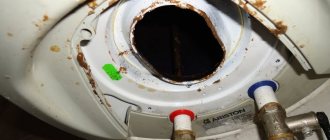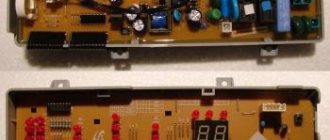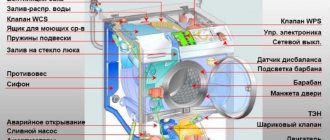The washing machine does not heat the water when washing. This problem occurs quite often, and there are many reasons why the water does not heat up. It is very important to eliminate this problem, because washing different types of laundry requires a certain temperature.
Every housewife knows that in order to achieve the best washing result, you should select the desired temperature mode. For this purpose, there is a special tag on things, which indicates a point or digital value of the recommended temperature. If woolen items are washed in cold water, then bed linen or towels are washed in water heated to a certain temperature. But what to do if the washing machine does not heat the water? This article will describe and analyze the main causes of this malfunction, as well as ways to solve them.
How to check if a washing machine is heating water
A situation may occur when the washing unit has fully completed all stages of washing, but the laundry was poorly washed, although the same detergent was used. One of the reasons may be non-compliance with the temperature regime. In other words, the machine washed clothes in cold water. In this case, it is worth checking whether the water entering the washing drum is heating up.
To do this, you need to select one of the washing modes, which involves heating the water to a temperature of 50-60*C and 20 - 30 minutes after it starts, touch the glass of the loading hatch. For top-loading machines, place your palm on the top cover. If these elements are warm, the water heats up; if they are cold, the washing unit is faulty. After finishing washing, you should identify the causes of the malfunction and eliminate the malfunction. Further use of the washing machine will not only not lead to the desired washing result, but may also render it completely unusable.
What to do when the machine washes with cold water
Regardless of why there is cold water in the washing machine, the problem must be corrected. To do this, call a repairman. He carries out diagnostics, finds the faulty element and replaces it. Each of the above breakdowns can be fixed easily and quickly if an experienced repairman works.
Any problems with the washing machine will be fixed by a specialist from the Top-Refit company. You can invite him to your home in Moscow at a time convenient for you.
Why you should entrust equipment repair to us:
- repair of any household appliances at home;
- there is all the equipment necessary for diagnostics and repair;
- original or manufacturer-recommended spare parts;
- affordable prices;
- neat, fast work with quality assurance.
Washing in cold water is not the most difficult problem that washing machines have. It can be easily fixed, and then the equipment will work just as well as before the repair.
Reasons why the washing machine does not heat the water
A washing unit is a complex household device consisting of many elements. The reason for the lack of water heating may be a malfunction or breakdown of:
- heating element (heating element);
- water heating sensor (thermostat);
- programmer (electronic unit);
- water level sensor in the tank (pressostat).
Also, the water may not heat up enough when:
- incorrect connection of the washing unit to the drainage system, resulting in self-draining of heated water caused by the siphon effect;
- incorrect choice of washing program, in which the selected mode in favor of a higher temperature mode is ignored.
There are many reasons why the machine does not heat the water, so in order to find out the source of the malfunction, you need to follow the principle “from simple to complex.”
Main reasons
The washing machine consists of many parts, so it is impossible to say for sure which part is “covered.” But here are some signs to understand why the machine takes a long time to heat the water or does not heat at all.
Error when selecting mode
First of all, check the wash program. You may have chosen a quick 30-minute cycle or a delicate cycle - with them the washing temperature does not exceed 30 degrees, so hot water is not needed. Change the program and monitor the behavior of the washer.
Problems with the heating element
The reason may be a breakdown of the water heater - a breakdown of the tubular structure, burnout due to power surges - or the wires that come from the heating element: if they are torn or broken, the heating, of course, does not work.
Water level sensor malfunction
The water level in the tank is controlled by a pressure switch. He does this using a tube that is attached to the membrane. One of the reasons for a malfunctioning pressure switch and poor water heating is a blockage that forms in the tube due to debris. The blockage can be cleared. It's another matter if the sensor itself breaks down. Only its complete replacement will help, more details here.
The heating sensor has failed
The water in the tank is heated to a certain temperature. The thermostat installed in the heating element is responsible for this. When the liquid reaches a certain degree (about 40-60 degrees), the temperature relay turns off the voltage supply to the heating element. If the unit is broken, the control module does not receive notification from the thermostat and does not turn on the heater. The thermostat cannot be repaired - only replaced with a new one.
When purchasing, take the broken part to the store and ask for its analogue, or better yet, an identical one. With other spare parts, the washing machine may not work properly.
Scale
Not everyone has water from Lake Baikal flowing through their pipes, so scale forms on the heating element. Salts are applied layer by layer, preventing the heating element from working at full strength. Liquid from the water supply contains various salts of chemical elements: magnesium, iron, potassium. Because of them, the liquid becomes hard, which leads to scale. The heating element generates heat, the salts decompose, spreading carbon dioxide and lime deposits. This causes corrosion of the heating element housing, followed by breakdown to the housing.
The scale, in turn, is deposited on the parts of the washing machine, clogging the nozzles and causing leaks from under the tray. This process is aggravated by the fact that the owner of the device often resorts to washing at high temperatures.
The programmer or control module is faulty
These parts send signals to turn on the heating element. They can fail due to a glitch in the program or a breakdown of the electrical element: it can burn out from a power surge or break due to vibration of the machine.
Characteristic signs of failure:
- The water overheats very much, sometimes it boils and steam comes out.
- Or vice versa, the glass of the hatch remains slightly heated or completely cold.
Incorrect connection
Perhaps you had a repair and had to take the machine to another room and then reconnect it.
- Household appliances are connected incorrectly, for example, without grounding, the device may knock out plugs.
- If you assemble the water supply incorrectly, using unsuitable adapters, there may not be enough water pressure, because of this the control module may block the supply of current to the heating element.
Carefully inspect the connections, and then read our article.
Other breakdowns
- Water is constantly being collected and drained without having time to warm up - read here.
- The drum is humming and not spinning - read here.
- The equipment was working, but suddenly all the indicators went out and the washing stopped - read here.
Identifying the faulty element
If periodic self-draining of warm or hot water occurs (can be monitored by heating the drain hose), it is necessary to eliminate the siphon effect and correctly connect the washing unit to the drain system. The problem is successfully solved by installing a check valve in the system.
If the washing machine does not heat the water at all, you should remove the back or side covers and check the connection of the heating element terminals (TENA) with the current-carrying wires.
When washing, especially in spin modes, all elements of the washing unit are subject to vibration loads, which can lead to separation of the elements. By reconnecting the disconnected wire, you can eliminate the problem.
Washing units from Samsung, LG, Ariston, Candy, Bosch and other well-known brands have a similar structure and connection of heating elements. As a rule, a tubular heating element is used, which converts electrical energy into thermal energy by creating electrical resistance.
How to determine the problem
After washing, the laundry is cold because rinsing is always done in cool water. You should also pay attention to what program is running. For example, washing machines from Indesit, Bosch and other well-known brands have built-in programs for silk and synthetic items that include washing in cold water.
Many washing machines have delicate programs
In some washing machines of the LG, Beko and some other brands, the washing temperature and its mode are selected by different switches. If the wash program and the corresponding temperature indicators do not match, the SMA may not heat the water. You can check the compliance of washing programs and water temperatures by reading the instructions included with each machine.
Switch for selecting temperature (more often and mode) of washing
If you suspect that the water in the drum does not heat up during washing, you can check this without a thermometer. Load the laundry and run a washing program with a temperature of at least +60 ℃. After 20–30 minutes, put your hand on the hatch door and make sure that it is warm - this means that the water in the tank has warmed up. If the hatch remains cold, it means that the SM does not heat the water.
Diagnostics of heating element
Failure of the heating element is the most common reason that the water in the washing machine does not heat up. Under normal conditions, the heating element is designed for a long period of operation, 5 - five or more years. However, hard water, low-quality detergents or failure to comply with the operating conditions of the washing unit lead to the formation of scale on the heating element. As a result of this, the heat transfer process is disrupted, the heating element overheats and burns out.
Electric heating elements are used in many household appliances: kettles, pressure cookers, boilers, etc. They can be dry or wet type. Dry heating elements do not come into direct contact with water or other liquid. Washing units from most manufacturers use wet heating elements. Korean washing machines Samsung and LG, Italian Ariston or German Bosch are all equipped with similar heating elements. They may vary in appearance and power.
Household washing units use heating elements with a power of 1.5 to 2.5 kW. The power is usually indicated on the device case, or in the accompanying technical documentation. In order to make sure that the heating element is working, you need a multimeter (tester). To ensure an accurate check, it is better to calculate the resistance for a specific element using the formula:
R=U²/P where:
R – resistance in Ohm;
U – network voltage in V;
P – heating element power W.
For example, let's take a heating element with a power of 2000W (or 2 kW).
R= 220²/2000= 24.2 Ohm
The calculated resistance for a 2 kW heating element was 24.2 Ohms.
To check you need:
- disconnect the wires from the heating element connectors;
- switch the multimeter to resistance measurement mode with a measurement range of no more than 1000 Ohms;
- Touch the probes of the multimeter to the outer terminals (contacts) of the heating element.
If the heating element is working properly, the device readings should be close to the calculated value. “Zero” indicates a short circuit inside the heating element and it needs to be replaced. If the device readings show “one” or the “infinity” symbol, the heating element has a break, and it also requires replacement.
To check the breakdown on the body, the tester switch is set to the “buzzer” mode and one of the probes of the device is connected to one of the contacts of the tank, the other to the body of the heating element. If there is no breakdown in the housing, the multimeter's buzzer will not sound. Otherwise, if the device beeps or displays numbers, then there is a breakdown in the housing, and the heating element requires replacement.
Finding and eliminating the causes of failure
The most popular models of washing machines: Samsung, Bosch, Ariston, Candy, Indesit. Most people use them, so the main problems are discussed using their example:
The cause of the breakdown may be overheating of the heating element.
If an automatic washing machine does not heat the water, then a breakdown of the heating element is the most common reason. The heating element is an electric heater, which is precisely responsible for heating the water. There can be many reasons: short circuit, voltage drops, age of the washing machine. The heating element lasts no more than five years, after which it must be changed.
Due to the fact that the heater is constantly in water, scale forms on it. If no other faults are found, and the heating element is completely covered with scale, it should be cleaned. To do this, add citric acid to water and boil. To avoid scale in the future, you should regularly clean it with anti-scale agents or run water and lemon in the washing machine. To ensure that clean water enters the machine, you can install a filter.
If the scale is removed and the water is still cold, then the problem may be an open circuit. In order to check this, you need to remove the bottom wall of the machine and check the integrity of the wires. If the wires are broken, they can be replaced with new ones. The heating element itself may burn out.
Self-replacement of the heating element
New heating element for washing machine
It is necessary to remove the old heater and insert a new one into the mounting hole in the washing machine. It is important to remember what position the old electric heater was in and install the new one in exactly the same way. Next, a nut is installed on the stud and tightened with a wrench. After this, you can connect the wires and put the machine wall back.
You can call a specialist for this work, but installing the heating element yourself will take a minimum of time and effort. After installation, start washing at low temperature. After 15 minutes, check the hatch for temperature.
Temperature sensor failure
The location of the thermostat depends on the car model. It is located either in the electric heater itself or on the surface of the tank. The thermostat monitors the water temperature and gives signals to heat up if necessary.
The thermostat is equipped with a special sensor that ensures timely heating and cooling of water. If this sensor is faulty, the water cannot be heated. You can check the status of the sensor as follows:
- Take it out of the washing machine and check the resistance with a multimeter;
- Place in hot water and repeat the procedure;
- If the hot and cold measurements do not differ significantly from each other, the thermostat must be replaced.
Checking the sensor with a multimeter
To replace the temperature sensor, it is better to contact a specialist, as this is not an easy procedure. But, if you have certain skills, you can handle it yourself. It should be remembered that there are different types of sensors in the washing machine.
Replacing different temperature sensors:
- Gas-filled sensor. It is an empty metal washer with a diameter of 3 centimeters. Located at the bottom of the tank. The part responsible for measuring the water temperature is located in the tank itself. The outer part is a thin tube that connects the inner part to the temperature controller. The washer contains a gas that is responsible for regulating the temperature of the water. By contracting, it sends the necessary signal to the sensor.
Gas-filled sensor
- To fix the problem, you need to carefully remove the broken sensor without damaging the attached tube. The tube is disconnected from the wires and the regulator. The new sensor is inserted exactly the opposite way. It is attached to the tube, connected to the wires and secured in the tank. To make the sensor fit tighter, it is better to fix it with superglue;
- Bimetallic sensor. Externally, this device is similar to the previous one, but the difference is this: inside it contains not gas, but a bimetallic plate. The plate is responsible for controlling water: the contacts close at a certain temperature - heating stops, and vice versa.
Bimetallic sensor - The sensor must be carefully removed from the tank and the wires disconnected. The new sensor is also lubricated with superglue for greater strength;
- Thermistor. Most often found in modern models of washing machines. It has a cylindrical shape and a length of about 3 centimeters. The mechanism of operation is simple: electrical resistance decreases significantly when heated, and the thermistor itself controls the water temperature.
Thermistor - To replace it, you need to remove all the water, loosen the attached heating element, disconnect the wires and remove the mechanism. To install a new thermistor, you need to connect the wires, secure the electric heater and insert the new mechanism. No additional fastening is needed.
Programmer failure
If the heating element is in order, the temperature sensor is correct and the washing machine is connected correctly, then the problem is most likely in the programmer itself. The programmer controls all programs and modes and is the “brain” of the washing machine.
The reasons for the breakdown can be different: as a rule, it is careless handling of the device. Sometimes it’s enough that a small child starts pressing buttons and turning the handle while doing laundry. In this case, the machine can easily fail.
Children's pranks can damage the programmer
If the programmer breaks down after recently purchasing a washing machine, the cause may be a manufacturing defect. Voltage surges and water entering the programmer itself cannot be ruled out.
In washing machines such as Samsung or Bosch, the programmer has a fairly simple mechanism and, if desired, you can fix it yourself.
Repairing the Ariston washing machine programmer:
- Take the removed faulty programmer and inspect it carefully. Pry the latches on the side of the cover and remove it;
- Carefully remove the board that is under the cover and set it aside;
- Carefully remove the gears and check them for dust or dirt. It happens that cleaning the gears is enough for the programmer to work properly;
- Inspect the board. If there are burns, then carefully solder them again;
- Check the resistance on the contacts and troubleshoot if any;
- Finally disassemble the mechanism and inspect all parts for their integrity. If faulty parts are found, replace them;
- Reassemble the programmer in reverse order.
Temperature sensor diagnostics
If the heating element is working properly, but the water in the washing machine does not heat up, we check the water heating sensor in the washing tank.
As a rule, it is located on the body of the heating element and is a small metal cylinder with connected electrical wires, however, on some units, for example Bosch, its appearance may be different. To do this you will need:
- disconnect the sensor wires and carefully remove it from the tank;
- use a multimeter to measure its resistance and remember the readings of the device;
- place the sensor in hot water and measure the resistance again; if the difference in readings is significant, the sensor is working; if not, it needs to be replaced.
Diagnosis and solution of the problem
Faced with the problem of lack of water heating during the washing process, it is necessary to analyze the condition of the device and the performance of the components that are involved in the process.
How to make sure there is no heating?
When it seems that the water was not heated when washing your LG, you should make sure that this is really the case. The fact that the things that are taken out of the washing machine drum after processing are cold does not mean anything, since after washing the laundry is rinsed in cold water.
If you are in doubt about the degree of water heating, you must:
Make sure that the water heating mode is selected. Some programs run either without heating at all or heat the water slightly, for example, when processing in the “wool” mode.- During the washing process, the machine begins to heat the water gradually. On average, 10-15 minutes after startup, you can check whether heating has started. This can be done by carefully touching the glass of the hatch.
Modern models of LG washing machines, if the heating specified by the program does not occur, in most cases stops washing and displays an error code indicating a failure.
Draining and adding water
Washing machines can go wrong in any way. If you have any doubts about the quality of the wash and the water heating process, this point should be monitored. When operating correctly, the machine draws water and begins washing, gradually heating the water.
But when a failure occurs, a situation with spontaneous discharge of water and its constant topping up is possible . In this case, the process simply does not reach the start of heating, so the heating element does not even turn on.
In such a situation, you should stop the program, drain the water and take a closer look at why the water is being dumped. This could be a leak, a malfunction in the installation of the drain filter when installing the washing machine, etc.
Heating element failure
Failure of a heating element is not such a rare occurrence . The reason for the breakdown of the LG machine can be:
- poor quality tap water;
- using unsuitable detergents;
- foreign objects getting into the drum, and from it into the tank;
- development of service life.
In order to determine the condition of the heating element, it is necessary to gain access to it. This is done from the back wall of the washing machine.
To determine the condition of the part, it is disconnected from the contacts and the fasteners holding the heating element are unscrewed. After this, the heating element is carefully removed and inspected. For accurate diagnostics, a multimeter is used.
The heating element should be removed carefully so as not to damage the tank and the “socket” in which the heating element is placed.
How to replace the heating element in an LG washing machine can be seen in the video:
Failure of the pressure switch
If the temperature sensor breaks down, the washing machine is unable to determine that the indicator does not reach the required value and there is no heating. If the pressure switch is broken, it is replaced with a new part. The sensor is not repaired.
Control module malfunction
Failure of the control module may be due to voltage surges , moisture or mechanical damage. In the case when the block that is responsible for issuing the command to the heating element to produce heating breaks down, the program crashes.
Repairing a control board is a complex process, so it is better to entrust the work to a specialist.
Checking the pressure switch
If the heating element and temperature sensor are working properly, and the washing machine does not heat the water, you need to check the water level sensor in the tank (pressostat).
If the pressure switch tube is clogged with lint and small debris, it may result in the sensor not sending a signal that the washing tank is full of water. As a result, the control module does not turn on the heating element, or does not give a signal to open the intake valve. As a result, the water does not heat up in the washing machine. You can determine the blockage visually by removing the top or side cover of the washing unit and removing the tube.
Relay repair
A relay, or otherwise a pressure switch, is also the reason why there is no water heating. Its main task is to give the machine a timely signal to the control unit that the required water level has been reached. You need to close the valve to start the water and turn on the heating.
If the water level switch tube is clogged with various lint from clothing, or hair from an animal, then the operation of the pressure switch with the machine control unit is disrupted. The liquid will be collected, but will not, the heating will turn on, and the washing will continue.
In this case, it would be correct to remove the tube and blow it out well. When the repair is completed, you need to check the heating element for leaks and its functionality. If the water heats up, then the washing machine works. Now you need to secure the wall of the machine body.
If you want to repair your washing machine yourself, then perhaps these tips will help you. But leave the troubleshooting of more complex breakdowns to professionals.
Repairs may take too long. To study all the issues and subtleties, and in the worst case, you can only create even more problems.
Checking the electronic module
Malfunctions in the operation of the programmer or control unit can be caused by both software failures and failure of the electrical part.
A voltage drop can lead to burnout of electrical components. Vibration loads cause mechanical damage to electrical circuit boards. All these reasons lead to programmer failures, and the signal to turn on the heating element is not given. At home, it will be difficult to identify the cause of the malfunction, and it is better to entrust the elimination of defects in the control unit to the service center technicians.
Attention! When carrying out all work on diagnosing and repairing the internal elements of the washing unit, it is necessary to disconnect it from the electrical circuit.
Does it heat or not: methods of determination
The washing machine heater is checked for functionality in several ways. At the same time, there is no need to open the case and look for many tools - a timer and a free hand are enough to carry out the procedure. The easiest way to test the heating element is as follows:
- load some laundry into the drum so as not to wash empty;
- select the “Cotton” mode or another program with a set temperature of 60-90 degrees;
- press the “Start” button;
- wait 15-20 minutes;
- Place your palm against the glass of the hatch door.
Modern machines can independently diagnose the system for breakdowns and display the corresponding error on the display (for example, H1, H2, NOT, HC, E5, E6).
If your hand feels warm, it means the heating element has heated the water. But an icy door does not always indicate problems with the heater. It is likely that the time was calculated incorrectly; the machine has already switched to rinse mode and is drawing cold water from the water supply . It is better to repeat the check and have time to apply your palm at the washing stage. There are other methods for testing heating elements.
- Feel the top cover of the case, which also heats up noticeably 15-20 minutes after washing at 60 degrees. Suitable for both front and vertical machines. This is especially true in the latest machines, since the first method does not work due to the missing glass door.
- Touch the drain hose while draining waste water. Here you will have to be patient and wait to accurately determine the moment of draining. Then all that remains is to take the hose in your hand and feel whether its walls are heated. There is a more indicative alternative: loosen the clamp on the drain pipe, drain the water into the bathtub or sink and measure its temperature.
- Pay attention to the electric brush. 7-10 minutes after starting the cycle, the washing machine will begin to intensively consume energy due to the activation of the heating element, which will be indicated by a flashing light on the meter. The main thing is to turn off all other household electrical appliances during the test to eliminate “interference.”
None of the methods listed above guarantees a 100% result. Ideally, the experiment should be repeated at least 3 times. Often, the heating element malfunctions due to accumulated plaque and scale, which provokes surges in water heating. A deviation from the norm is considered to be warm waste liquid, not heated to 50-90 degrees. If this is noticed, the heating element must be cleaned or replaced with a new one.
Trouble-shooting
If the heating element or temperature sensor fails, they are replaced with new ones. In order to correctly select a new element in a store or market, it is best to dismantle the old one and take it with you. The seller will select the necessary analogue. If the pressure switch tube is clogged, you must remove it from the sensor fitting and try to blow it out. If the tube is severely clogged, it is necessary to remove it completely and clean it using available means, such as soft wire.
Repair of such breakdowns in a specialized service, for example for residents of Novosibirsk - ob-service.ru, will cost from 1000 rubles.
To prevent scale from forming on the heating element, temperature sensor and other elements, it is recommended to use special products when washing, such as citric acid. Periodic measures aimed at descaling using special means extend the life of the elements responsible for heating the water in the washing machine.
Causes of malfunction
The washing machine may not heat the water for various reasons:
- The heating element (hereinafter also referred to as heating element) does not work.
- No voltage is supplied to the heating element. This malfunction is possible due to a broken cable chain.
- The control module in the electronic control unit (hereinafter also referred to as the ECU) is damaged.
- The pressure sensor in the tank - pressure switch is faulty. It does not send a signal to the ECU that the tank is full of water, so the heating does not turn on.
- The temperature sensor is broken. As a result, the ECU cannot recognize what the water temperature is in the tank.
You can localize and eliminate most causes yourself.
Scale on the heating element
Even if the heating element is working properly, it may not perform its functions. The reason is hard water, rich in calcium and magnesium salts. Salts form a layer of scale on the surface of the heating element and prevent the water from heating. In addition, thermal insulation leads to constant overheating of the heating element, and it eventually fails.
A layer of scale on the heating element of a washing machine
To restore the heating element’s functionality, you need to use one of the means for cleaning heating elements. The best way is to pour 100 g of citric acid into the powder tray, empty the drum of laundry and run the wash at a water temperature of +60 ℃ for 1.5 hours. During this time, the acid will clean the heating element from scale.
Heating element malfunction
What to do if the SM stops heating the water? If you have a multimeter, you need to check whether the heating element is working properly. In operating condition, its resistance should be from 24 to 40 Ohms. To check, follow these steps:
- Disconnect the device from the power supply.
- Remove the back cover of the CMA.
- Find the heating element - it is usually located at the bottom of the tank, under the drum.
- Remove the wires connected to the heater from the terminals.
- Measure the resistance with a multimeter.
The heating element is located at the bottom of the SM body, behind the back cover
If the heating element is faulty, the device will indicate an open circuit. Then do not rush to assemble the machine, but replace the burnt part with a working one. To do this, remove the fastening nut and carefully remove the heater from the seat using a screwdriver or other available tool. Instead, install a new part, connect the wires and carry out a test wash. At the same time, check whether the rubber gasket on the heating element that seals the tank is leaking.
The following video tells how to replace the heating element in a washing machine:
Broken wiring going to the heating element
The likelihood of this breakdown is low, but due to vibrations caused by spinning clothes, sometimes the circuit breaks. To localize the break, inspect the cable wiring inside the SMA. Solder the frayed wires, then insulate them securely. If no fault is found, call a qualified technician. It is quite possible that the wiring is fine, but the control unit is faulty.
Cable wiring coming from the heating element into the washing machine body
Electronic control unit does not work
The ECU is the “brain” of modern SMA. Washing programs and operating algorithms for all components of the washing machine are recorded in non-volatile memory chips - ROM. Sometimes the memory fails. In such cases, the information is re-entered - in the language of specialists, the memory chips are flashed using the reprogramming method.
Electronic board of the washing machine control unit
It is also possible that the ECU may break down due to oxidation or broken contacts in the connectors. To identify such defects, call a technician, since the control unit may be faulty for various reasons.
Temperature sensor failure
The temperature sensor (hereinafter also referred to as thermostat, thermistor) monitors the temperature of the water in the tank. Since each washing program runs at a certain temperature, the ECU compares the sensor information with the indicators stored in ROM.
This is what the thermistor looks like in most SMA models
The washing machine does not heat the water at all or brings it to a boil if the temperature sensor is faulty. In most SM models, this part is located next to the heating element or in the heater panel. You can check its performance with a multimeter.
If the thermostat is faulty, replace it as follows:
- open the back cover of the SM case;
- disconnect the connector with wires from the thermistor;
- carefully remove the sensor from the mounting socket;
- insert a new thermostat into the seat;
- connect the connector with wires to the thermistor.
Temperature sensor in the rear panel of the heating element
After watching the video, you will learn how to check the performance of a thermistor with a multimeter:
The pressure switch is inoperative
This device is designed to determine the water level in the tank. It measures the pressure that water creates using a tube connected to the sensor membrane. There are situations when the tube becomes clogged - pieces of fabric, animal hair and other small debris get there.
Pressostat in the washing machine
To clean the tube, open the top cover of the CM. Under it, on one of the side panels, there is a pressure sensor. Disconnect the tube by removing the clamp and clean it thoroughly. If cleaning does not help, replace the pressure switch.
To summarize, we can say: in most cases, the problem with heating water in a washing machine can be solved on your own.
Part Search
If you have doubts about the performance of the heating element, you will have to “ring” it with a multimeter. First you need to find the device itself in the machine. Its location largely depends on the manufacturer’s brand, for example, in Indesit and Ariston it is located at the back, in models from Bosch and Siemens it is at the front.
Having in hand the factory wiring diagram for the heating element in the washing machine, you can speed up the search.
If there are no instructions, then we look for the heater ourselves:
- We examine the back wall of the machine. Often a large panel indicates a heating element located behind it;
- put the body on its side or tilt it back to look into the bottom and try to detect the heating element near the washing tub;
- remove the back cover and carefully inspect the space around the tank;
- We take a flashlight, shine a light through the inside of the drum and try to determine by eye the location of the heater.
The task is simplified by the fact that the heating element is always in the washing tub. It is only necessary to specify its location. There is no need to remove the device - you can “ring” the heater without removing it. We’ll tell you how exactly later.











